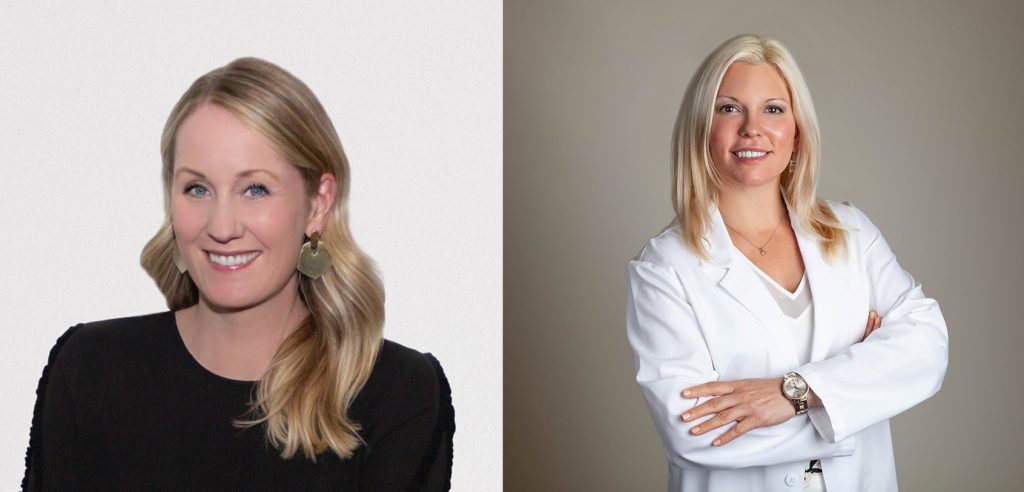PAs in Dermatology Offer Advice for Breaking into the Competitive Specialty
Persistence and Networking are Key, Experts Reiterate
April 7, 2022

By Katy Shenk
In AAPA’s recent Huddle Ask Me session, participants sought career advice from two experienced PAs who practice dermatology, and each entered the specialty at a different point in their medical careers. Amber Blair, MMS, PA-C, began practicing dermatology shortly after graduating from her PA program and has since pursued advanced training in cosmetic procedures. She currently teaches aesthetic medicine at CME meetings designed exclusively for PAs and NPs practicing in dermatology. Conversely, Kristin Rygg, MPAS, PA-C, spent seven years practicing as a hospitalist PA in gastroenterology and internal medicine before switching to dermatology. She is also a guest faculty at the University of Colorado PA program.
Blair and Rygg are heavily involved in multiple dermatology organizations. Both PAs serve as a director-at-large for the Society of Dermatology Physician Assistants (SDPA), AAPA’s largest constituent organization.
Starting out in Dermatology: Advice for Students
For PA students interested in pursuing a career in dermatology, Rygg advises seeking out an elective dermatology rotation, as it often serves as a working interview and many students are hired upon completion. Be reliable, prompt, and proactive; read about the cases you’re exposed to and come back with questions. Thank each provider at the end of the rotation and get hands on practice by drawing ‘lesions’ on an orange or by suturing on a banana or tortilla.
Enrolled in a PA program that doesn’t offer elective rotations? Don’t worry, Rygg says. “Many of us go into specialties we never even rotated in.” Focus on core curriculum offerings and network at dermatology conferences to help land a dermatology position, she says, emphasizing that breaking into the field comes down to “who you know, not what you know.”
Blair adds that some larger practices offer fellowship-style programs, usually about six months long, designed to train new grads in dermatology. Many practices incorporate shadowing or training with other providers. Ultimately, Blair finds that “the ED and any surgical opportunity can assist in bolstering your skill set to make you an outstanding candidate for a dermatology PA position.”
To supplement clinical experience, both hosts recommend joining SDPA as a student member for access to CME, dermatology education, conferences, and job postings.
Tips for Transitioning into Dermatology
Blair acknowledges that switching specialties to work in dermatology can seem daunting, as the field is highly competitive. To successfully navigate this transition, she advises becoming involved in local, state, and regional dermatology associations to maximize networking opportunities. If possible, get to know local PAs in dermatology and participate in shadowing on days off.
Recalling her own experience transitioning into the specialty, Rygg speaks to the importance of connecting with the dermatology community. Although it took her almost three years of searching, conference networking finally paid off. “There are definitely companies and physicians that will hire PAs without dermatology experience,” she reassures, “especially if you are willing to drive, relocate, or take a potential temporary pay cut while training.”
Both hosts advocate for utilizing SDPA membership resources, placing emphasis on SDPA’s Diplomate Fellowship Program. Designed to augment clinical training and standardize PA dermatology education, the program seeks to provide a comprehensive review of dermatology.
[Receive unparalleled career services and support – join or renew your membership today]
As an additional consideration for PAs hoping to make a specialty switch, Blair suggests seeking out positions in general or medical dermatology as opposed to aesthetic medicine. After landing a dermatology position, PAs will likely find more opportunities to pursue their ideal practice within the field. “I told my first dermatology employer that I wanted to ensure I was really good at medical and surgical dermatology before I added in cosmetics,” Rygg offers. “After you are practicing for a few years, you can easily adjust your schedule to ensure your expertise and interest areas align with the patients you are seeing.”
Getting Established in a New Position or Practice
It can be difficult to feel fully prepared when beginning a new dermatology position, whether entering the field directly from a PA program or transitioning from a prior specialty. Blair encourages self-advocating for comprehensive training and recommends preparing to “have very pointed conversations” with prospective employers to ensure this will occur.
When stepping into a new position as an experienced dermatology clinician, Blair estimates it may take 1-3 years to become fully established and build a regularly booked patient schedule. To further expand a private practice, “do your part to get patients in,” she says, and recommends social media marketing, grassroots networking, and meeting local referring providers to enhance personal and clinic visibility.
Read the full Ask Me session online and check out the dermatology section of AAPA’s Areas of Practice Guide.
You May Also Like
A Day in the Life of a PA in Dermatology
How to Tailor Your Job Application for a Specialty Transition
Emergency Medicine PAs Say Preparation and Experience Lead to Success
Thank you for reading AAPA’s News Central
You have 2 articles left this month. Create a free account to read more stories, or become a member for more access to exclusive benefits! Already have an account? Log in.


